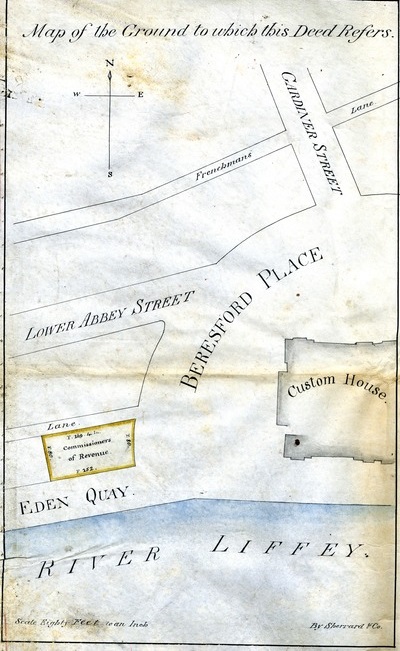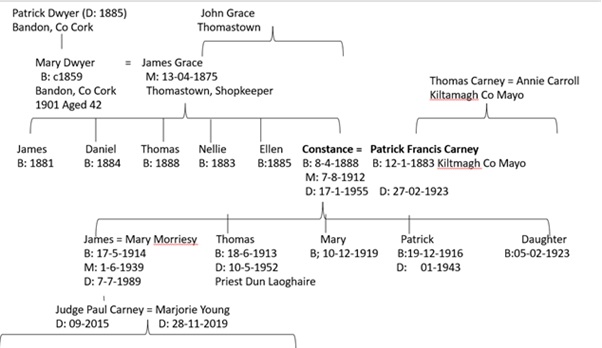Patrick Francis Carney: the first Revenue official to die in the Free State
The Centenary of Revenue gives us the opportunity to remember all deceased Revenue officials and their families. I would like to recall the first Revenue official to die in the course of his duties, Patrick Francis Carney.
On Wednesday 21 February 1923, the Irish Free State established the Office of the Revenue Commissioners. The first Commissioners were William O’Brien (1872-1941), Charles J Flynn and William D. Carey.
During the Civil War period (28 June 1922 to 3 March 1923), in excess of twenty attacks took place on Revenue offices, on Revenue officials and their homes.
On 21 February 1923, two Revenue Offices in Dublin were attacked and destroyed as part of the Civil War. The offices were located at 32 Nassau Street and 4 Beresford Place. Mr Patrick Francis Carney, an Excise officer, was in the offices at Beresford Place. At 1.30 pm, twelve armed men entered the Beresford Place building and ordered the staff on the ground floor into a back office. The raiders then sprinkled petrol on the books and documents and set fire to them and to the stairs. Upstairs were five officials who suffered injuries and burns as they made their way to the ground floor. The fire brigade arrived shortly after the fire started. The injured were taken to Jervis Street Hospital. The raiders took cash from the Collector’s Office. A compensation claim was made and this claim in now in the National Archives (FIN/1/2690).
Patrick Carney was badly wounded with burns to the upper body and head. He was discharged from Jervis Street hospital into the care of a doctor and nurse at his home. He showed initial signs of a recovery, but his condition deteriorated, and he died from his wounds on 27 February. An inquest was carried out on 1 March and on 2 March his funeral took place in Thomastown, Co Kilkenny. Patrick was buried in St Mary’s (Old) Graveyard in Thomastown. In the grave are his father-in law, James Grace and his mother-in-law Mary Grace, née Dwyer. Patrick was the first Revenue official to die in the course of his duties under the new Free State administration. His widow Constance gave birth to their fifth child just three days after she buried Patrick in her native Thomastown. She died on 17 January 1955 and is buried in Deansgrange Cemetery, Dublin. As an aside, it was Constance who gave the welcome address to Cardinal Moran, the first cardinal of Australia, when he visited his native Thomastown in 1902.
The story of Patrick Francis Carney begins on 12 January 1883 when he was born to Thomas Carney and Annie Carroll, near Kiltmagh in Co. Mayo. Patrick was educated locally and after completing the Civil Service exams in 1904, he was appointed an Excise officer in Thomastown, Co. Kilkenny. While staying in Grace’s Hotel in Market Street, he fell in love with the co-owner of the hotel, Constance Grace (1888-1955), the youngest of ten children of James Grace and Mary Dwyer. Patrick and Constance were married in Thomastown on 7 August 1912. They moved to live in Mountmellick and then Dundalk, before setting up home in Dublin at Harold’s Cross with their four children James, Thomas, Mary and Patrick. Their fifth child was born three days after Patrick was buried in Thomastown.
James Carney was a well noted Irish scholar and set up the Dublin Institute of Advanced Studies. James’s son, Mr Justice Paul Carney (27 April 1943 – 24 September 2015) was a grandson of Patrick Francis Carney and served as a judge of the High Court.
Another son, Thomas, became a Catholic Priest and was a curate at St Michael’s Dun Laoghaire; he died in 1952, aged only 38.
Beresford Place, the office attacked during the Civil War, was developed in 1792 as a continuous crescent which was aligned to the axis of the central dome of the Custom House. Along with the Custom House and the old Custom House Dock, the houses were also originally designed by James Gandon. The main crescent was developed specifically by John Claudius Beresford who served initially as a storekeeper for the port of Dublin and later as Inspector-General of Exports and Imports.
The Custom House was destroyed by fire in May 1921, and the Beresford Place office where Patrick Carney worked was the building used for the clearing of merchandise held in the Custom House Docks area.
Liberty Hall now stands on the site of the Revenue Commissioners offices at Beresford Place.

Map showing location and dimensions of premises marked 'Commissioners of Revenue' on the north of Eden Quay and west side Beresford Place. The map includes details of the surrounding area, including the Custom House, Lower Abbey Street, Gardiner Street, Frenchman's Lane and the River Liffey.

Family Tree Notes:
- Patrick Dwyer was Station Master with the Cork – Macroom Railway Company.
- Patrick Francis Carney is buried in St Mary’s (old) graveyard (CYMS) Thomastown.
- Ellen and Constance Grace ran a boarding house at Market Street, Thomastown.
- Constance (B:1888) siblings were, John (B: 1876 D:1880) Patrick (B:1877) James(B:1878) Anne (B:1880) Daniel (B: 1881) Ellen(B;1883) John (2nd) (B1884) Thomas(B:1885) Michael (B: 1886).
Sources:
- Damage to Property (Compensation) Act, 1923 – Claims
- Dictionary of Irish Biography (DIB)
- Ed Synott and Joe Doyle South Kilkenny Historical Society
- File Reference 2019/84/129
- File Reference OPW/6/1/12 and OPW/6/1/64 and OPW/6/1/65 and FIN/1/32
- Freemans Journal 6th March 1923
- Genealogy Ireland
- Irish Independent 23/07/1904
- Irish Times 1923-1955
- Kilkenny People Newspaper 1902 -1925
- National Archives
- Pat Cronin Parish Office, Thomastown